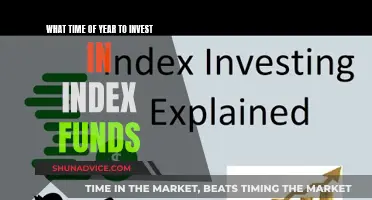
Inverse exchange-traded funds (ETFs) are a type of investment that can be used to profit from a falling market. They are designed for investors who want to maximise returns regardless of market direction and are often used by contrarian traders. Inverse ETFs are usually bought outright, which makes them less risky than other forms of bearish bets. They are also simple to invest in — an investor simply needs to buy shares in the ETF if they are bearish on a particular market, sector or industry. However, they are considered riskier than traditional ETFs and are not suitable for risk-averse investors.
| Characteristics | Values |
|---|---|
| Type of Fund | Exchange-traded fund (ETF) |
| How it Works | Designed to perform as the inverse of the index or benchmark it tracks; uses short selling, trading derivatives, and other leveraged investment techniques |
| Purpose | To profit from a decline in the value of an underlying benchmark; to hedge an investment portfolio |
| Holding Period | Designed for short-term investing as part of a market timing strategy; not suitable for long-term buy-and-hold investors |
| Risks | Compounding risk, derivative securities risk, correlation risk, short sale exposure risk, leverage risk, asset management responsibilities |
| Fees | Higher management fees and expense ratios compared to traditional ETFs |
What You'll Learn
- Inverse ETFs can be used to hedge a portfolio's exposure to market risk
- Inverse ETFs are designed for speculative traders and investors
- Inverse ETFs are risky assets that should be approached with caution
- Inverse ETFs are bought outright, making them less risky than other forms of bearish bets
- Inverse ETFs are not suitable for risk-averse investors

Inverse ETFs can be used to hedge a portfolio's exposure to market risk
Inverse ETFs are a type of exchange-traded fund (ETF) that seeks to deliver returns that are the inverse of the benchmark or index with which they are associated. For example, if the index increases by 1%, the ETF should theoretically decrease by 1%. These funds are designed for investors who want to maximise returns regardless of market direction and hedge their portfolio against market risk.
Inverse ETFs are also useful for investors who want to profit from a falling market without having to short any securities. For instance, during the market downturn in the first half of 2022, when inflation, rising interest rates, Fed tightening, and fears of a recession roiled equity markets, investors who were hedging their large-cap investments with the ProShares Short S&P 500 ETF (SH) could have seen reduced losses and improved volatility. With just a 10% hedge position in SH, returns could have been improved by over 4% and volatility reduced by 5%.
However, it is important to note that inverse ETFs carry unique risks, such as compounding risk, derivative securities risk, correlation risk, and short sale exposure risk. These funds are designed for speculative traders and investors seeking tactical day trades and are not suitable for risk-averse investors.
Best Mutual Funds: Where to Invest Smartly
You may want to see also

Inverse ETFs are designed for speculative traders and investors
Inverse ETFs are exchange-traded funds that use derivative contracts to deliver positive returns from a decline in the value of an underlying asset or market index. They are also referred to as short ETFs or bear ETFs because they focus on profiting from negative returns. Inverse ETFs are designed for investors who want to maximize investment returns regardless of market direction and hedge their portfolio against market risk.
Inverse ETFs are similar to other packaged investment products like mutual funds but with some compelling differences. Like mutual funds, inverse ETFs can provide investors with a diversified portfolio of securities designed to meet a wide range of investment objectives. However, unlike mutual funds, inverse ETFs trade on exchanges and are continuously priced in real time, much like equity securities. This makes inverse ETFs ideal for providing investors with access to sophisticated investment strategies that are unavailable in long-only portfolios and other strategically allocated investment programs.
Inverse ETFs seek investment results that correspond to the inverse (opposite) of the benchmark or index with which they are associated. For example, if an inverse ETF seeks to track the inverse performance of the Standard & Poor's 500 Index, it will reflect a loss of 1% for every 1% gain in the index. These funds only seek investment results that are the inverse of their benchmarks' performances for one day, and investors who wish to hold inverse ETFs for longer must actively manage and rebalance their positions to mitigate compounding risk.
Investing in inverse ETFs is quite simple. If you anticipate a downturn in a particular market, sector, or industry, you can buy shares in the corresponding ETF. To exit the position, simply place an order to sell when you think the downturn has run its course. Inverse ETFs also provide access to professional investment management, as it is extremely difficult to successfully trade options, futures, sell short, or speculate in the financial markets.
Trust Fund Investment: A Guide to Getting Started
You may want to see also

Inverse ETFs are risky assets that should be approached with caution
Inverse ETFs are designed for investors who want to profit from a falling market without short-selling securities. They are designed for tactical day trades against their respective underlying indexes. However, they carry unique risks that investors should be aware of before investing in them.
Inverse ETFs are generally designed to deliver returns that are the inverse of their benchmarks' performance for one day only. For example, if an inverse ETF tracks the inverse performance of the Standard & Poor's 500 Index, it will reflect a loss of 1% for every 1% gain in the index. This is known as compounding risk, which affects inverse ETFs held for longer than one day.
Another risk associated with inverse ETFs is derivative securities risk. Inverse ETFs often use derivative securities such as swaps, forwards, futures contracts, and options to achieve their investment results. These derivatives are considered aggressive investments and expose inverse ETFs to additional risks, such as correlation risk, credit risk, and liquidity risk.
Additionally, inverse ETFs may also carry short sale exposure risk. They may seek short exposure through the use of derivative securities, which can lead to increased volatility and decreased liquidity, potentially resulting in losses.
Inverse ETFs also tend to be more expensive than traditional index funds due to higher operating expenses. The complexity of these financial instruments can also lead to unexpected losses, especially if the market moves against the investor. Therefore, holding such funds for longer than a day is considered very risky.
Overall, inverse ETFs are not suitable for risk-averse investors. They are best suited for sophisticated, highly risk-tolerant investors who are comfortable with the inherent risks. Investors should carefully consider their investment objectives and risk tolerance before investing in inverse ETFs.
Invesco Funds: A Guide to Getting Started with Investing
You may want to see also

Inverse ETFs are bought outright, making them less risky than other forms of bearish bets
Inverse ETFs are a type of exchange-traded fund (ETF) that allows investors to profit from a falling market without short-selling securities. They are designed for investors who want to make tactical day trades against specific indexes or sectors. These ETFs are often used by investors who are bearish on a particular market, sector, or industry and want to profit from a downturn.
Inverse ETFs are bought and sold like regular stocks on major stock exchanges through standard brokerage accounts. They are easy to buy and provide access to a wide range of investment strategies. However, it is important to note that inverse ETFs are designed for short-term bets and are not suitable for a buy-and-hold strategy.
One of the main advantages of inverse ETFs is that they do not require a margin account, which is typically needed for short-selling. This means that investors can avoid the costs associated with borrowing from a broker. Additionally, inverse ETFs provide access to professional investment management, as the advisor to the ETF handles the short-selling on the investor's behalf.
Another benefit of inverse ETFs is that they do not require investors to open separate futures or options trading accounts. Most brokerage firms restrict investors from engaging in complex investment strategies unless they can demonstrate the necessary knowledge and experience. With inverse ETFs, less experienced investors can still gain exposure to these strategies.
While inverse ETFs offer certain advantages, they also carry unique risks. One of the main risks is compounding risk, which occurs when inverse ETFs are held for longer than one day. This is because inverse ETFs are designed to provide inverse returns of their underlying indexes for a single day. Holding them for longer periods can lead to compounding returns that deviate from the fund's investment objective.
Another risk associated with inverse ETFs is derivative securities risk. Many inverse ETFs use derivative instruments such as swaps, futures contracts, and options to gain exposure to their underlying indexes. These derivatives are considered aggressive investments and can expose the ETFs to correlation risk, credit risk, and liquidity risk.
In conclusion, inverse ETFs are bought outright, and this makes them less complex and risky than other forms of bearish bets, such as short-selling. However, it is important for investors to understand the unique risks associated with inverse ETFs and ensure that these investments align with their financial goals and risk tolerance.
Rockbridge Fund: A Guide to Investing Wisely
You may want to see also

Inverse ETFs are not suitable for risk-averse investors
Inverse ETFs carry many risks and are designed for sophisticated, highly risk-tolerant investors who are comfortable with the risks involved. They are designed for investors seeking to make tactical day trades against their respective underlying indexes.
Inverse ETFs are subject to compounding risk, which affects those held for longer than a day. They also carry derivative securities risk, as they employ derivatives, which are considered aggressive investments. This exposes them to correlation risk, credit risk, and liquidity risk. They are also subject to correlation risk, caused by high fees, transaction costs, expenses, and investing methodologies.
Additionally, inverse ETFs may seek short exposure through the use of derivative securities, exposing them to the risks associated with short-selling securities, including increased volatility and decreased liquidity.
Another risk of inverse ETFs is leverage. The use of derivatives involves margin, which creates leverage and can lead to undesirable situations. Leveraged futures positions can fluctuate dramatically in price, resulting in inefficient markets and inaccurately priced positions within the ETF portfolio. This can lead to ETF share prices that are not precisely correlated with the underlying benchmark.
In summary, inverse ETFs carry various risks that make them unsuitable for risk-averse investors. These risks include compounding risk, derivative securities risk, correlation risk, short sale exposure risk, and the potential for dramatic losses due to leverage.
A Beginner's Guide to Index Fund Investment on E-Trade
You may want to see also
Frequently asked questions
An inverse ETF is an index ETF that gains value when its correlating index loses value. It does so by holding assets and derivatives, like options, that are used to create profits when the underlying index falls.
Inverse ETFs are thought to be riskier than traditional ETFs, but they're bought outright. This makes them less risky than other forms of bearish bets. There's often unlimited risk when an investor shorts an asset. The investor could end up losing much more than they had anticipated.
One of the main risks of inverse ETFs is their lack of popularity. You can buy many types of ETFs, but you won't find a huge selection of inverse ETFs. You'll likely find that inverse ETFs have less liquidity than other ETFs due to fewer options and less demand.
You can buy inverse ETFs at any of the best brokers for stock trading. There are plenty of ETF screening tools, including those provided by most brokerage firms. While factors such as management fees and daily trading performance are important considerations, you should thoroughly review the fund’s prospectus.







